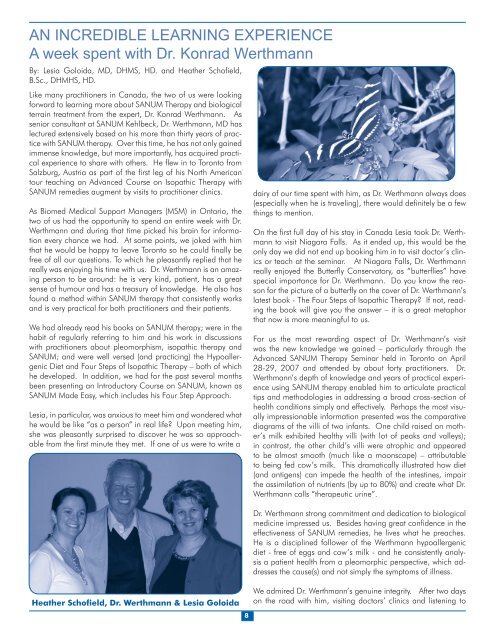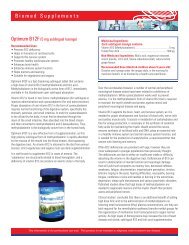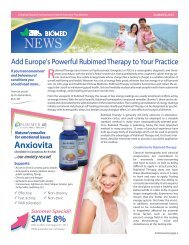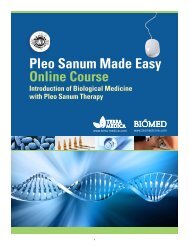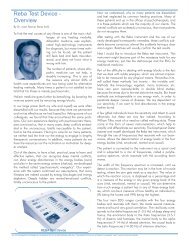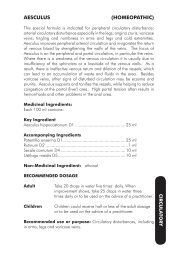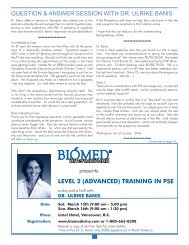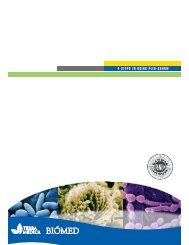AN INCREDIBLE LEARNING EXPERIENCE A week spent with Dr ...
AN INCREDIBLE LEARNING EXPERIENCE A week spent with Dr ...
AN INCREDIBLE LEARNING EXPERIENCE A week spent with Dr ...
You also want an ePaper? Increase the reach of your titles
YUMPU automatically turns print PDFs into web optimized ePapers that Google loves.
<strong>AN</strong> <strong>INCREDIBLE</strong> <strong>LEARNING</strong> <strong>EXPERIENCE</strong><br />
A <strong>week</strong> <strong>spent</strong> <strong>with</strong> <strong>Dr</strong>. Konrad Werthmann<br />
By: Lesia Goloida, MD, DHMS, HD. and Heather Schofield,<br />
B.Sc., DHMHS, HD.<br />
Like many practitioners in Canada, the two of us were looking<br />
forward to learning more about S<strong>AN</strong>UM Therapy and biological<br />
terrain treatment from the expert, <strong>Dr</strong>. Konrad Werthmann. As<br />
senior consultant at S<strong>AN</strong>UM Kehlbeck, <strong>Dr</strong>. Werthmann, MD has<br />
lectured extensively based on his more than thirty years of practice<br />
<strong>with</strong> S<strong>AN</strong>UM therapy. Over this time, he has not only gained<br />
immense knowledge, but more importantly, has acquired practical<br />
experience to share <strong>with</strong> others. He flew in to Toronto from<br />
Salzburg, Austria as part of the first leg of his North American<br />
tour teaching an Advanced Course on Isopathic Therapy <strong>with</strong><br />
S<strong>AN</strong>UM remedies augment by visits to practitioner clinics.<br />
As Biomed Medical Support Managers (MSM) in Ontario, the<br />
two of us had the opportunity to spend an entire <strong>week</strong> <strong>with</strong> <strong>Dr</strong>.<br />
Werthmann and during that time picked his brain for information<br />
every chance we had. At some points, we joked <strong>with</strong> him<br />
that he would be happy to leave Toronto so he could finally be<br />
free of all our questions. To which he pleasantly replied that he<br />
really was enjoying his time <strong>with</strong> us. <strong>Dr</strong>. Werthmann is an amazing<br />
person to be around: he is very kind, patient, has a great<br />
sense of humour and has a treasury of knowledge. He also has<br />
found a method <strong>with</strong>in S<strong>AN</strong>UM therapy that consistently works<br />
and is very practical for both practitioners and their patients.<br />
We had already read his books on S<strong>AN</strong>UM therapy; were in the<br />
habit of regularly referring to him and his work in discussions<br />
<strong>with</strong> practitioners about pleomorphism, isopathic therapy and<br />
S<strong>AN</strong>UM; and were well versed (and practicing) the Hypoallergenic<br />
Diet and Four Steps of Isopathic Therapy – both of which<br />
he developed. In addition, we had for the past several months<br />
been presenting an Introductory Course on S<strong>AN</strong>UM, known as<br />
S<strong>AN</strong>UM Made Easy, which includes his Four Step Approach.<br />
Lesia, in particular, was anxious to meet him and wondered what<br />
he would be like “as a person” in real life? Upon meeting him,<br />
she was pleasantly surprised to discover he was so approachable<br />
from the first minute they met. If one of us were to write a<br />
Heather Schofield, <strong>Dr</strong>. Werthmann & Lesia Goloida<br />
8<br />
dairy of our time <strong>spent</strong> <strong>with</strong> him, as <strong>Dr</strong>. Werthmann always does<br />
(especially when he is traveling), there would definitely be a few<br />
things to mention.<br />
On the first full day of his stay in Canada Lesia took <strong>Dr</strong>. Werthmann<br />
to visit Niagara Falls. As it ended up, this would be the<br />
only day we did not end up booking him in to visit doctor’s clinics<br />
or teach at the seminar. At Niagara Falls, <strong>Dr</strong>. Werthmann<br />
really enjoyed the Butterfly Conservatory, as “butterflies” have<br />
special importance for <strong>Dr</strong>. Werthmann. Do you know the reason<br />
for the picture of a butterfly on the cover of <strong>Dr</strong>. Werthmann’s<br />
latest book - The Four Steps of Isopathic Therapy? If not, reading<br />
the book will give you the answer – it is a great metaphor<br />
that now is more meaningful to us.<br />
For us the most rewarding aspect of <strong>Dr</strong>. Werthmann’s visit<br />
was the new knowledge we gained – particularly through the<br />
Advanced S<strong>AN</strong>UM Therapy Seminar held in Toronto on April<br />
28-29, 2007 and attended by about forty practitioners. <strong>Dr</strong>.<br />
Werthmann’s depth of knowledge and years of practical experience<br />
using S<strong>AN</strong>UM therapy enabled him to articulate practical<br />
tips and methodologies in addressing a broad cross-section of<br />
health conditions simply and effectively. Perhaps the most visually<br />
impressionable information presented was the comparative<br />
diagrams of the villi of two infants. One child raised on mother’s<br />
milk exhibited healthy villi (<strong>with</strong> lot of peaks and valleys);<br />
in contrast, the other child’s villi were atrophic and appeared<br />
to be almost smooth (much like a moonscape) – attributable<br />
to being fed cow’s milk. This dramatically illustrated how diet<br />
(and antigens) can impede the health of the intestines, impair<br />
the assimilation of nutrients (by up to 80%) and create what <strong>Dr</strong>.<br />
Werthmann calls “therapeutic urine”.<br />
<strong>Dr</strong>. Werthmann strong commitment and dedication to biological<br />
medicine impressed us. Besides having great confidence in the<br />
effectiveness of S<strong>AN</strong>UM remedies, he lives what he preaches.<br />
He is a disciplined follower of the Werthmann hypoallergenic<br />
diet - free of eggs and cow’s milk - and he consistently analysis<br />
a patient health from a pleomorphic perspective, which addresses<br />
the cause(s) and not simply the symptoms of illness.<br />
We admired <strong>Dr</strong>. Werthmann’s genuine integrity. After two days<br />
on the road <strong>with</strong> him, visiting doctors’ clinics and listening to
him being asked for advice on treatment protocols, we began<br />
to develop a very clear sense for applying the Werthmann approach<br />
to S<strong>AN</strong>UM therapy. Although the conditions changed<br />
from patient to patient there was a definite pattern of consistency<br />
to his recommendations. Essentially, <strong>Dr</strong>. Werthmann’s protocol<br />
for any condition divides into three parts:<br />
1. modify the diet - remove primary antigens, in particular<br />
dairy and eggs<br />
2. check the teeth - eliminate any focal infection and look for<br />
a connection between the tooth <strong>with</strong> foci<br />
and the affected organ<br />
3. implement the Four Step Approach <strong>with</strong> S<strong>AN</strong>UM therapy<br />
A further experience we had <strong>with</strong> <strong>Dr</strong>. Werthmann came as a<br />
complete surprise to us. We were visiting a naturopathic clinic<br />
where a case was presented of the patient suffering from neuromuscular<br />
disorder. It was pointed out that one peculiar aspect<br />
of this patient’s history was his tendency to accidentally break<br />
his bones in various places. We assumed that once again <strong>Dr</strong>.<br />
Werthmann would recommend a regime of S<strong>AN</strong>UM therapy.<br />
However, he asked a question instead: What is the relationship<br />
between the patient and his mother? We were all puzzled!<br />
Then, <strong>Dr</strong>. Werthmann explained that the patient’s physical illness<br />
is probably of psychosomatic origin. He went on to postulate<br />
that the patient has always relied on his “broken bones” as a<br />
reason (or justification) to be able to run back to his mother for<br />
attention and affection.<br />
Lesia was even more impressed when she had the opportunity to<br />
test “the Broken Man” three days later on the REBA test device.<br />
According to her PSE test, his emotional conflict (Emvita 11-<br />
Hungry) was located in Chakra 3, the autonomic nervous centre<br />
located in the upper abdomen. The meaning of this emotional<br />
conflict is: “You feel frustrated, powerless and cheated out of<br />
9<br />
a sense of well-being. You want to be cared for, to feel that<br />
somebody loves you. You feel the need to protect your boundaries<br />
and the nice things in life that could bring you joy.” When<br />
this was revealed to the patient, he said that he could relate to<br />
the conflict statement and expressed an eagerness to start the<br />
Rubimed remedies to address the condition.<br />
In other words, <strong>Dr</strong>. Werthmann had diagnosed this patient perfectly!<br />
Through this patient, we had learned something unexpected<br />
from <strong>Dr</strong>. Werthmann and more about him. Being curious,<br />
Heather asked him how he had learned so much about the<br />
body-mind connection and to incorporate it into his practice.<br />
To this he revealed that for years he has shared breakfast every<br />
morning <strong>with</strong> a colleague who practices Psychotherapy and they<br />
would discuss their experiences <strong>with</strong> one another. His paying as<br />
much attention to the patient’s mental and emotional state as<br />
to their physical complaints further confirms his standing as a<br />
holistic practitioner.<br />
The <strong>week</strong> we <strong>spent</strong> <strong>with</strong> <strong>Dr</strong>. Werthmann was very busy <strong>with</strong> practitioner<br />
visits and the two-day seminar. Yet, being both Medical<br />
Support Managers and practitioners, we both felt fortunate to<br />
be able to spend so much time <strong>with</strong> such a teacher. We had the<br />
opportunity to ask <strong>Dr</strong>. Werthmann hundreds of questions and<br />
each time <strong>with</strong>out hesitation he would provide us <strong>with</strong> a consistent,<br />
well-reasoned and practical response.<br />
Our <strong>week</strong> was a very enriching experience. We are convinced<br />
more than ever, that Isopathic Therapy <strong>with</strong> S<strong>AN</strong>UM remedies<br />
is very effective way to successfully treat any chronic condition,<br />
by addressing the state of the body’s terrain instead of masking<br />
over symptoms. We look forward to sharing this deeper knowledge<br />
and outlining effective means of treating patients holistically<br />
through addressing the root causes of disease. ��<br />
The Four Steps of Isopathic Therapy<br />
Prevention and Treatment<br />
By: <strong>Dr</strong>. Konrad Werthmann<br />
If you acquire no other book on S<strong>AN</strong>UM therapy this should be the one!<br />
This book serves well the author’s intended purpose: “…to be an introduction to S<strong>AN</strong>UM<br />
isopathic treatment for practitioners. In particular, it is intended for persons who want to<br />
start using S<strong>AN</strong>UM isopathic treatment or who have attended an introductory seminar and<br />
wish a complementary reference book as well.” Advanced practitioners indicate they also<br />
find it a helpful resource tool.<br />
Presented so it is easy to comprehend <strong>with</strong> good explanations, topics covered include: all<br />
the fundamental components of isopathic therapy, an explanation of pleomorphism, a description<br />
of all categories of Isopathic S<strong>AN</strong>UM remedies, a details review of the Four Step<br />
Approach to S<strong>AN</strong>UM therapy and the Werthmann Hypoallergenic Diet. It even provides<br />
some recipes and much more.<br />
Contact Biomed to Order Your Copy Today!


